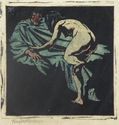
19th, 20th & 21st Century Fine Prints
707-546-7352 · fax 707-546-7924 · web: www.annexgalleries.com · email: artannex@aol.com
Haydn Reynolds Mackey Biography
Haydn Reynolds Mackey
British
1883–1979
Biography
Haydn Reynolds Mackey was a British painter and illustrator. Born in King’s Lynn, Norfolk in 1883 the artist began his artistic education at the Slade School of Art in London. Mackey served as an Official War Artist during the First World War, and was stationed with the Royal Army Medical Corps on the Western Front. The artist received great acclaim for his depiction of life during the war, his immediacy to the suffering and hardship of active soldiers imbued his work with raw emotional truth. Mackey’s representation of life on the front line included scenes of domestic duties that were rarely seen.
Following the War, Mackey came to be well regarded as a more commercial artist. His innovative approach to printmaking established the artist as a particularly fine illustrator. Mackey developed his own method of colour printing, whereby the artist would produce single impression linocuts printed on fine transparent sheets which were then hand painted in bold colours using oil paints. The artist used this method regularly in his work for the Mandrake Press, through which he illustrated several literary publications. The artist was also well regarded as a more traditional painter, and exhibited often in Paris, France where he was awarded a multitude of prizes at international fairs. From the 1930s onwards, Mackey taught at the Walthamstow School of Art for a significant period. The artist died in 1979. His work remains in a number of eminent collections, including those of the Imperial War Museum and the Royal Academy.
The bold coloured linocuts of printmaker and book illustrator Haydn Reynolds Mackey represent an innovative departure from recognised methods of colour printmaking. Although they appear, at first sight, to be multiple colour printed linocuts on heavy wove oatmeal paper, this is not the case. They are, in fact, single impression linocuts printed in black ink on fine tracing-style tissue paper which Haydn Mackey then hand-painted and presented in a manner unique to his work.
Having printed his linocut in black ink, H.R.Mackey would hand colour each proof with thick opaque oil paint on the reverse of the fine transparent printed sheet. He would then apply this hand coloured proof on to a heavy oatmeal backing paper, paint surface downward. Once the printed sheet was perfectly adhered to the backing, he would trim the edges so that both sheets appear as one. The resulting effect is for the strong oil colours to show through the transparent paper of the proof print, giving the appearance of a perfectly registered multiple colour printing of the finest and most even nature.
Haydn Reynolds Mackey’s prints are consistently rare, having never been published in formal editions. It is likely that the time and difficulty involved in producing each final colour print precluded the production of these prints on a commercial scale. Mackey’s works of this nature remain some of the most striking linocuts produced in England at this time, outside the Grosvenor School.
Source: Campbell Fine Arts and others.

